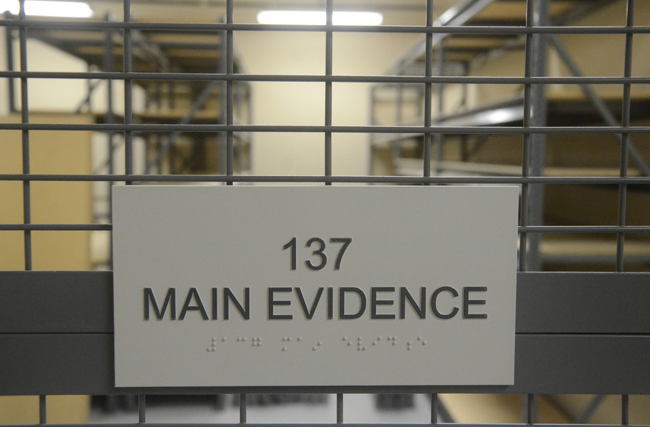Sheriff’s Potentially Sick Building Testing Done in 1 Day, Results Not Expected Until July
There was [an] evidence room deputy who had breathing problems while working in that room.
June 22, 2018
The scientist Flagler County government hired to further and more broadly analyze air, soil ceiling and wall samples at the Sheriff's potentially sick Operations Center in Bunnell told the county today the gathering of samples was completed in one 11-hour day and the results are expected at the end of July. That means nearly 70 sheriff's employees will have to continue working outside the building for at least that long.
The Sheriff's Office completed its evacuation of the building last week. The evacuation included Sheriff Rick Staly and his command staff, to the county courthouse and the old sheriff's administration building near the jail. By then more than two dozen employees had filed workers' compensation claims over health issues related to the building's interiors, prompting the sheriff to order the evacuation and press for immediate re-testing.
The building, a reconstructed structure that used to be a hospital until the early 2000, then sat fallow until it was rebuilt in 2014-15, is the county's responsibility. The sheriff is a tenant. A more localized round of testing in two rooms last fall did not solve the problem.
County Administrator Craig Coffey hired Zdenek Hejzlar, an environmental engineer, to conduct the new round. That took place from 10 a.m. to 11 p.m. on June 14. Some employees witnessed the testing as it was being conducted, according to Hejzlar's three-page memo to County Engineer Faith Al-Khatib, summarizing the work.
The memo doesn't add new insights into what may be causing employees' health issues. But it outlines the extent and type of testing that was conducted, if in mostly scientific language. The scope of testing appears not to have been unusually extensive or systematic. One distinct finding: "We found a leak and condensation issues in the Bio evidence room between the freezer and the cooler," Hejzlar wrote. "The wall between the units was wet and stained with what appeared to be active mold growth."
While collecting dust samples, Hejzlar also found "a disproportionate amount of white specks in some of the dust," which was traced to ceiling tiles. Those will also be analyzed. Further, Hejzlar found the relative humidity in the building to be pushing 60 percent, the upper limit of comfort zones, and in some cases spiking past that, resulting in "clammy" conditions, and in various odors of volatile organic compounds. The memo does not specify what sort.
The testing collected dust samples for mold analysis from 23 locations in the building, including some locations suggested by employees. "We concentrated on locations with heavy dust settlement to evaluate worst case condition and representative of multiple days that it took for the dust to settle. We specifically did not test areas that were recently cleaned," Hejzlar wrote.
He also collected five ambient air samples and two samples from soils beneath the building's six-inch concrete slab. "We also drilled the slab and obtained some relative moisture content readings in the slab," Hejzlar wrote.
Based on Hejzlar's summary, the testing conducted at the Sheriff's Operations Center contrasts somewhat with an Environmental Protection Agency briefing and its cautions about testing: Although air sampling for contaminants might seem to be the logical response to occupant complaints, it seldom provides information about possible causes," the briefing states. While certain basic measurements, e.g., temperature, relative humidity, CO2, and air movement, can provide a useful 'snapshot' of current building conditions, sampling for specific pollutant concentrations is often not required to solve the problem and can even be misleading. Contaminant concentration levels rarely exceed existing standards and guidelines even when occupants continue to report health complaints."
Air sampling should not be undertaken, the briefing continues, until considerable information on such factors as chemical and biological contaminants has been collected, "and any sampling strategy should be based on a comprehensive understanding of how the building operates and the nature of the complaints." Hejzlar's memo to Al-Khatib does not include a discussion of those strategies.
The following day Hejzlar and his colleague met with county administration staffers and "removed two outlet covers to enable inspection of copper wire for any evidence of corrosion. We found them to be in excellent condition." He said he also inspected the building visually from outside and asked for additional records regarding the sort of paint used for the building and information about carpeting, tiles and insulation.
Coffey has been leading the effort after sustained pressure from Staly, and appears occasionally to have gotten involved in the details, down to requesting the type of testing he wanted: "I want to test for mold on Marijuana," he told Al-Khatib on June 7. "This mold has a special name. There was [an] evidence room deputy who had breathing problems while working in that room. Since being reassigned on the road has cleared up. They are saying if bad enough it could get into the blood as well. That might be something to be added to the scope. This issue if part of the problem is very fixable." There does not seem to have been any marijuana-mold testing.



